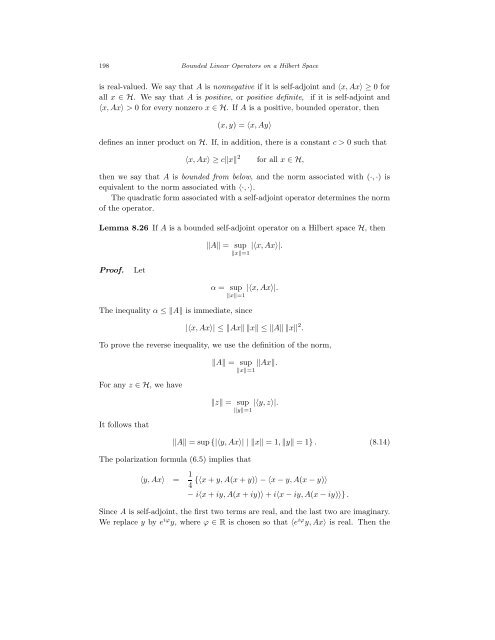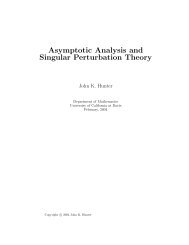Bounded Linear Operators on a Hilbert Space
Bounded Linear Operators on a Hilbert Space
Bounded Linear Operators on a Hilbert Space
You also want an ePaper? Increase the reach of your titles
YUMPU automatically turns print PDFs into web optimized ePapers that Google loves.
198 <str<strong>on</strong>g>Bounded</str<strong>on</strong>g> <str<strong>on</strong>g>Linear</str<strong>on</strong>g> <str<strong>on</strong>g>Operators</str<strong>on</strong>g> <strong>on</strong> a <strong>Hilbert</strong> <strong>Space</strong><br />
is real-valued. We say that A is n<strong>on</strong>negative if it is self-adjoint and 〈x, Ax〉 ≥ 0 for<br />
all x ∈ H. We say that A is positive, or positive definite, if it is self-adjoint and<br />
〈x, Ax〉 > 0 for every n<strong>on</strong>zero x ∈ H. If A is a positive, bounded operator, then<br />
(x, y) = 〈x, Ay〉<br />
defines an inner product <strong>on</strong> H. If, in additi<strong>on</strong>, there is a c<strong>on</strong>stant c > 0 such that<br />
〈x, Ax〉 ≥ cx 2<br />
for all x ∈ H,<br />
then we say that A is bounded from below, and the norm associated with (·, ·) is<br />
equivalent to the norm associated with 〈·, ·〉.<br />
The quadratic form associated with a self-adjoint operator determines the norm<br />
of the operator.<br />
Lemma 8.26 If A is a bounded self-adjoint operator <strong>on</strong> a <strong>Hilbert</strong> space H, then<br />
Proof. Let<br />
A = sup |〈x, Ax〉|.<br />
x=1<br />
α = sup |〈x, Ax〉|.<br />
x=1<br />
The inequality α ≤ A is immediate, since<br />
|〈x, Ax〉| ≤ Ax x ≤ A x 2 .<br />
To prove the reverse inequality, we use the definiti<strong>on</strong> of the norm,<br />
For any z ∈ H, we have<br />
It follows that<br />
A = sup Ax.<br />
x=1<br />
z = sup |〈y, z〉|.<br />
y=1<br />
A = sup {|〈y, Ax〉| | x = 1, y = 1} . (8.14)<br />
The polarizati<strong>on</strong> formula (6.5) implies that<br />
〈y, Ax〉 = 1<br />
{〈x + y, A(x + y)〉 − 〈x − y, A(x − y)〉<br />
4<br />
− i〈x + iy, A(x + iy)〉 + i〈x − iy, A(x − iy)〉} .<br />
Since A is self-adjoint, the first two terms are real, and the last two are imaginary.<br />
We replace y by e iϕ y, where ϕ ∈ R is chosen so that 〈e iϕ y, Ax〉 is real. Then the
















